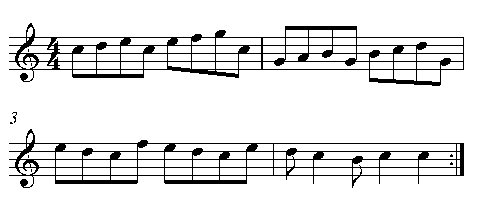
| ||||||||||||||||
When playing from middle D (fingering 2) to middle E (fingering X 123 45) the recorder is said to be 'crossing the break'. If you slur from D to E you will hear a click as the recorder moves from a fundamental mode (the D) to a first harmonic mode (the E). The fundamental E (fingering 0 123 45) will sound a middle E if you tongue or blow hard. This is the instrument moving from one harmonic mode to the next. By venting the thumbhole the fundamental mode is suppressed and we hear only the first harmonic. When tonguing from D (fingering 2) to E (fingering x 123 45) there should be no click because the act of tonguing, if hard enough, is itself sufficent to excite the second harmonic, the middle E. This exercise takes the player across the break both upwards and downwards.
If you try the same piece slurring each group of four quavers (eight notes) you will begin to see how obtrusive the 'break' is. It can be solved in two ways. One way is to use alternative fingerings for D (123 4567) and E (123 4 67). This may be used when moving up or down, although it is strictly only necessary when moving up. The other alternative is to replace the slur with very legato playing, hiding the fact by tonguing gently and moving the fingers very neatly and quickly between notes. Try both methods and see which suits you better.
